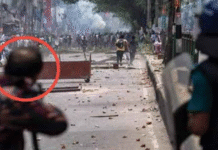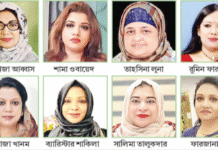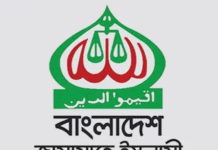Bangladeshi lawmaker Talukder Mohammad Towhid Jung Murad was guest of honour at the August 2010 inauguration of a five-storey building in his constituency named Rana Plaza. Three years later he was back, this time helping pull survivors from the rubble.
Now, two weeks after the block collapsed killing more than 900 people, Murad is facing a furious backlash from grieving families, some of whom say they want him hanged for his role as a political patron of the block’s owner.
“I rescued 320 people alive,” Murad told Reuters. “But now I’m a villain.”
His words have a hollow ring to relatives clinging to a vanishing hope that rescue crews will retrieve something recognizable of their missing loved ones, many of them young seamstresses, whose bodies lie buried in a morass of fallen concrete in Savar, Murad’s gritty industrial constituency outside the capital Dhaka.
“Murad should be strung up in public,” said Babul Islam, clutching a photograph of his younger sister, shown wearing mascara and a heart-shaped pendant, who worked at New Wave Style, one of the garment businesses in Rana Plaza.
Such hostility is best understood against the backdrop of a broader phenomenon in Bangladesh that has implications for some of the biggest retailers in the West: a dangerous intersection between criminality, politics and the apparel industry.
In Savar, the controversy hinges on allegations that Murad served as the protector of Mohammed Sohel Rana, the owner of Rana Plaza, who also has emerged as a hate figure to some for assuring factory bosses and reporters the building bearing his name would stand “for a century”. It collapsed the next day.
Bangladeshi legislators have often been accused of using their influence over local police to shield small-time hoodlums from arrest in return for their help in organising protests that are a staple of the country’s confrontational politics.
A number of labour leaders, businessmen and residents say Murad forged just such a patron-client relationship with Rana, who they described as an intimidating figure who roamed Savar with a biker gang at his back, and a pistol tucked in his jeans.
Allegations from survivors and relatives of the victims that Rana’s followers bullied workers into re-entering the doomed building despite doubts about its safety have turned both men into a lightning rod for local anger.
“Definitely, Murad is responsible for this disaster,” said Ashraf Uddin Khan, a former chairman of Savar council who, like Murad, is a member of the ruling Awami League.
“Sohel Rana supplied muscle…to Murad,” Khan added. “Sohel Rana is his biggest supporter.”
Murad said in brief remarks by telephone that he could not be blamed for the disaster since the building had been started before he took office in 2008 and he was not an engineer responsible for overseeing safety standards in his constituency.
He subsequently said he was unable to attend a planned interview with Reuters due to a conflicting commitment.
Rana was arrested after a four-day manhunt, apparently trying to flee to India. He and the other eight suspects detained in connection with the disaster, including four factory bosses, have not made any public statements.
Police said Rana has yet to find a lawyer willing to represent him due to the hostility he faces. He appeared in court in a bullet-proof vest and helmet for his own protection.
Thugs, Drugs and Votes
Once consigned to the outermost rim of the global economy, Bangladesh, a country of 160 million people, is now the second biggest garment exporter after China. Companies such as Walmart Stores Inc, Tesco Plc and H&M, rely on its rock-bottom labour costs to boost their margins, but labour activists say safety in some factories is still an afterthought.
In the days since Rana Plaza’s implosion, the world’s worst industrial disaster since Bhopal in 1984, Western buyers and the Bangladeshi government have come under renewed pressure to find ways to tighten oversight of the sector, which employs 4 million people and accounts for 80 per cent of exports.
In Savar, some locals say their district is a case study of the way in which a nexus of grubby street politics, money and the insatiable demand for space unleashed by the clothing industry has complicated the task of imposing controls.
A scrappy neighbourhood of workshops and residential streets framed by a vista of brick kilns and pylons, Savar’s recent history is one of helter-skelter industrialisation, labour unrest and, most recently, calamities. A fire at a clothing factory in a nearby district in November killed 112 people.
As investors sought a slice of the burgeoning garments business, a rash of new buildings sprang up in the district, including Rana Plaza. Apparel makers rented the upper floors, while Rana used his headquarters in the basement to run criminal rackets from extortion to illicit drugs, some locals said.
Mohammad Asaduzzaman, the chief of Savar police, said he had heard verbal reports from residents that Rana was involved in selling illegal narcotics, but that nobody had ever filed the kind of formal complaint needed to trigger an investigation.
Savar residents believe Rana spotted a chance to bolster his position by backing’s Murad’s run for office in 2008.
Murad had spent almost 10 years studying and working in real estate in the United States, according to his website, but had returned to Bangladesh to follow in the footsteps of his father, a respected politician.
“Rana threatened people that if you do not vote for Murad it will be very difficult for you to stay here,” said a Savar man who went to school with Rana, but who declined to be named for fear of reprisals.
Ali Haider, General Secretary of the Awami League in Savar, denied the allegations of wrong-doing against Rana and Murad, saying they had been spread since the disaster to score political points.
“Is it wise to threaten voters before an election?” Haider said.
A kiss is just a kiss?
Following Murad’s election win, locals said Rana became more brazen, roaming Savar in a three-car convoy backed with stick-wielding thugs who would clear a path through traffic.

With Murad’s support, he assumed a leadership position in the youth wing of the Awami League’s Savar branch, which provided a formal avenue within the party structure for his work organising rallies, according to residents and Khan.
Bangladeshi media interpreted photos that circulated on social media after the disaster as evidence of a growing bond.
In one, Murad is shown kissing Rana on the forehead — an exceptional expression of esteem in Bangladeshi culture.
In another, Murad is depicted leading a rally where supporters are brandishing a banner heralding Rana as an Awami League youth leader. In a third, Rana waves from the sun roof of a car in a triumphal Awami League parade.
After his arrest, Rana told interrogators that he had provided men and vehicles to boost the numbers at Murad’s rallies, said Habibur Rahman, chief of Dhaka district police.
Murad has told Bangladeshi media that he met many people through his political role and Rana was merely an acquaintance. “Since I am engaged in politics — I only know him — that is all,” Murad said in an interview with ATN television. “I have no family relationship or business relations.”
“National Hero”
As Rana’s profile in Savar grew, so did Rana Plaza. After the inauguration, he added three more floors — an extension that violated city building codes, according to the chief engineer of Dhaka’s development authority.
Floor-space was snapped up by garment workshops who won contracts to make items for retailers including Britain’s Primark and Italy’s Benetton.
Primark said it did not know the premises were unsafe. Benetton said it had no dealings with any Rana Plaza factory, but it had since learned that one of its former suppliers occasionally sub-contracted work to a firm there.
As sewing machinists on the upper floors stitched at a frenetic clip, tensions were mounting on the streets ahead of elections due in early 2014, where the Awami League will face a stiff challenge from the Bangladesh Nationalist Party (BNP).
Many Savar locals believe Rana’s value to the ruling party was sharpened by his ability to summon rallies to counter strikes called by the opposition BNP to demand Prime Minister Sheikh Hasina step down ahead of the polls.
When a crack crept up the wall of Rana Plaza, worrying workers and attracting the attention of news crews, Rana assured reporters that the building would stand for “a century”, according to video broadcast on ETV, a Bangladeshi private TV station.
The following day, April 24, threatening men ordered workers to go back inside, survivors said.
“They told us to go to work, otherwise we would not get our April wages and face dismissal,” said Mohammad Parvez, who worked on the seventh floor at New Wave Style, and who was later plucked from the wreckage.
Shortly before 9am the electricity went off, as it often does in Bangladesh. When the heavy generators inside Rana Plaza were started, floors and ceilings gave way in a cascade of bursting walls, tumbling equipment and screams.
Within days, protests broke out in Savar as furious workers demanded Murad’s arrest. When the Prime Minister toured the site, she pointedly avoided him.
As anger boiled on the streets, Murad told ATN that he thought he would have been hailed as a national hero for his rescue work, which was filmed by news crews. He then added his voice to the clamour for Rana to stand trial.
“Even if he was my own brother I would surrender him to the authorities,” Murad said. “Am I a man without conscience?”
Source: Bd news24










